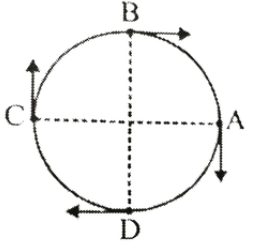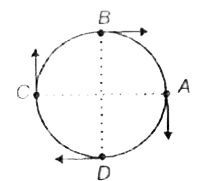Two cities AandB are connected by a regular bus service with buses plying in either direction every T seconds. The speed of each bus is uniform and equal to Vb. A cyclist cycles from A→B with a uniform speed of Vc. A bus goes past the cyclist in T1 second in the direction A→B and every T2 second in the direction B→A. Then
T1=VbTVb+Vc
T2=VbTVb−Vc
T1=VbTVb−Vc
T2=VbTVb+Vc
The correct Answer is:C, D
To solve the problem, we will analyze the situation step by step, focusing on the relative motion between the cyclist and the buses traveling between cities A and B.
Step 1: Understanding the Problem
- We have two cities, A and B, connected by a bus service.
- Buses travel from A to B and from B to A every T seconds.
- The speed of the buses is Vb.
- A cyclist travels from A to B at a speed of Vc.
- We need to find the time taken for a bus to pass the cyclist in both directions.
Step 2: Distance Between Buses
- The distance between two consecutive buses traveling in the same direction (either A to B or B to A) can be calculated as:
Distance=Vb×T
- This distance is the same for both directions since the buses are spaced evenly.
Step 3: Analyzing the Bus Passing the Cyclist from A to B
- When a bus passes the cyclist traveling from A to B, the relative speed of the bus with respect to the cyclist is:
Vrelative=Vb−Vc
- The time taken for the bus to pass the cyclist (denoted as T1) can be expressed as:
T1=Distance between busesRelative speed=Vb×TVb−Vc
Step 4: Analyzing the Bus Passing the Cyclist from B to A
- When a bus is traveling from B to A, the relative speed of the bus with respect to the cyclist is:
Vrelative=Vb+Vc
- The time taken for the bus to pass the cyclist in this case (denoted as T2) can be expressed as:
T2=Distance between busesRelative speed=Vb×TVb+Vc
Step 5: Conclusion
- We have derived the expressions for T1 and T2:
- T1=VbTVb−Vc
- T2=VbTVb+Vc
Final Answer
- The correct expressions for the times are:
- T1=VbTVb−Vc (Option C)
- T2=VbTVb+Vc (Option D)
- We have two cities, A and B, connected by a bus service.
- Buses travel from A to B and from B to A every T seconds.
- The speed of the buses is Vb.
- A cyclist travels from A to B at a speed of Vc.
- We need to find the time taken for a bus to pass the cyclist in both directions.
- The distance between two consecutive buses traveling in the same direction (either A to B or B to A) can be calculated as:
Distance=Vb×T
- This distance is the same for both directions since the buses are spaced evenly.
- When a bus passes the cyclist traveling from A to B, the relative speed of the bus with respect to the cyclist is:
Vrelative=Vb−Vc
- The time taken for the bus to pass the cyclist (denoted as T1) can be expressed as:
T1=Distance between busesRelative speed=Vb×TVb−Vc
- When a bus is traveling from B to A, the relative speed of the bus with respect to the cyclist is:
Vrelative=Vb+Vc
- The time taken for the bus to pass the cyclist in this case (denoted as T2) can be expressed as:
T2=Distance between busesRelative speed=Vb×TVb+Vc
- We have derived the expressions for T1 and T2:
- T1=VbTVb−Vc
- T2=VbTVb+Vc
- The correct expressions for the times are:
- T1=VbTVb−Vc (Option C)
- T2=VbTVb+Vc (Option D)
Topper's Solved these Questions
- KINEMATICS-2BOOK - CENGAGE PHYSICS ENGLISHCHAPTER - KINEMATICS-2EXERCISE - Exercise Assertion - Reasoning
5 Videos
- KINEMATICS-2BOOK - CENGAGE PHYSICS ENGLISHCHAPTER - KINEMATICS-2EXERCISE - Exercise Comprehension
21 Videos
- KINEMATICS-2BOOK - CENGAGE PHYSICS ENGLISHCHAPTER - KINEMATICS-2EXERCISE - Exercise Single Correct
76 Videos
- KINEMATICS-1BOOK - CENGAGE PHYSICS ENGLISHCHAPTER - KINEMATICS-1EXERCISE - Integer
9 Videos
- KINETIC THEORY OF GASESBOOK - CENGAGE PHYSICS ENGLISHCHAPTER - KINETIC THEORY OF GASESEXERCISE - Compression
2 Videos
Similar Questions
Two towns A and B are connected by a regular bus service with a bus leaving in either direction every T min. A man cycling with a speed of 20kmh−1 in the direction A to B notices that a bus goes past him every 18min in the direction of his motion, and every 6min in the opposite direction. What is the period T of the bus service and with what speed (assumed constant )do the buses ply on the road?
View SolutionConsider two cities P and Q between which consistent bus servece is available in both directions every x mimutes. A morning jogger is jogging towards Q from P wigh a speed of 10kmh−1. Every 18mim a bus crosses this jogger in its own direction of motion and every 6min another bus crosses in opposite direction. What is time preriod between two consecutive buses and also find the speed of buses ?.
View Solution
Knowledge Check
Two town A and B are connected by a regular bus service with a bus leaving in either direction every T minutes. A man leaving in either direction every in the direction A to B notices that a bus goes past him every 18 min in the direction of his motion, and every 6 min in the opposite direction. The period T of the bus service is
A4.5 minB9 minC1.2 minD24 minA passenger getting down from a moving bus, falls in the direction of the motion of the bus. This is is an example for
Asecond law of motionBsecond law of motionCsecond law of motionDinertia of motionA car starts from rest moves with uniform acceleration a1 for t1 second and then retards uniformly at a rate a2 for t2 second. Then t1/t2 is equal to
Aa1/a2Ba2/a1Ca22/a1D2a1/a2
Four particles A, B, C and D are moving with constant speed v each. At the instant shown relative velocity of A with respect to B, C and D are in directions :-

View SolutionTwo particles A and B get 4m closer each second while traveling in opposite direction They get 0.4 m closer every second while traveling in same direction. The speeds of A and B are respectively :
View SolutionFour particles A, B, C and D are moving with constant speed v each at the instant shown relative velocity of A with respect to B, C and D are in directions

View SolutionA bus is moving on a straight road towards north with a uniform speed of 50 km/hour turns left through 90∘. If the speed remains unchanged after turning, the increase in the velocity of bus in the turning process is
View SolutionA bus starting from rest moves with a uniform acceleration of 0.1m/s2 for 2 minutes. Find
(a) the speed acquired, (b) the distance travelled.
View Solution
